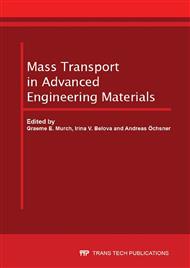[1]
M. Soustelle in: Cinétique Hétérogène 1, modélisation des mécanismes, edited by Hermes sciences publications, Lavoisier (2006).
Google Scholar
[2]
H. Toulhoat and P. Raybaud in: Catalysis by transition metal sulphides from molecular theory to industrial application, edited by Editions Technip (2013)C. Ratnasamy and J.P. Wagner: Catalysis Reviews, Vol. 51 (2009), p.325.
DOI: 10.1016/j.jcat.2013.06.011
Google Scholar
[4]
J.B. Chung and J.S. Chung: Chem. Eng. Sci. Vol. 60 (2005), p.1515.
Google Scholar
[5]
V. Girard, A. Baudot, D. Chiche, D. Bazer-Bachi, C. Bounie and C. Geantet: Fuel Vol. 128 (2014), p.220.
DOI: 10.1016/j.fuel.2014.02.058
Google Scholar
[6]
A. Angelis: Appl; Catal. B-Environ. Vol. 113-114 (2012), p.37.
Google Scholar
[7]
D. Chiche, C. Diverchy, A.C. Lucquin, F. Porcheron and F. Defoort: Oil Gas Sci. Technol. Vol. 68 (2013), p.707.
DOI: 10.2516/ogst/2013175
Google Scholar
[8]
L. Neveux, D. Chiche, J. Pérez-Pellitero, L. Favergeon, A. -S. Gay and M. Pijolat: Phys. Chem. Chem. Phys. Vol. 15 (2013), p.1532.
DOI: 10.1039/c2cp42988h
Google Scholar
[9]
L. Neveux, D. Chiche, D. Bazer-Bachi, L. Favergeon and M. Pijolat: Chem. Eng. J. Vol. 181-182 (2012), p.508.
DOI: 10.1016/j.cej.2011.09.019
Google Scholar
[10]
J. Skrzypski, I. Bezverkhyy, O. Heintz and J. -P. Bellat: Ind. Eng. Res. Vol. 50 (2011), p.5714.
Google Scholar
[11]
P.R. Westmoreland and D.P. Harrisson: Environ. Sci. Technol. Vol. 10 (1976), p.659.
Google Scholar
[12]
S. Plimpton: J. Comput. Phys. Vol. 117 (1995), p.1.
Google Scholar
[13]
R.A. Buckingham: P. Roy. Soc. Lond. A Mat. Vol. 168 (1938), p.264.
Google Scholar
[14]
D.J. Binks in: Computational modelling of Zinc Oxide & related oxide ceramics thesis manuscript, University of surrey (1994).
Google Scholar
[15]
K. Wright and R.A. Jackson: J. Mater. Chem. Vol. 5 (1995), p. (2037).
Google Scholar
[16]
J.E. Basconi and M. R. Shirts: J. Chem. Theory Comput. Vol. 9 (2013), p.2887.
Google Scholar
[17]
F. Agullo-Lopez, C.R.A. Catlow and P.D. Townsend in: Point Defect in Materials, Academic Press: London (1988).
Google Scholar
[18]
L. Minervini, M.O. Zacate and R.W. Grimes: Solid State Ionics Vol. 116 (1999), p.339.
Google Scholar
[19]
F. Shüth, S. Kenneth, W. Sing and J. Weitkamp in: Handbook of Porous solids, volume 3 edited by Wiley-VCH (2002).
Google Scholar
[20]
F.A. Kröger and H.J. Vink in: Relations between the concentrations of imperfections in crystallines solids, edited by F. Seitz and D Turnbull, volume 3 of Solid State Physics Advances in Research and Applications, Academic Press (1956).
DOI: 10.1016/s0081-1947(08)60135-6
Google Scholar
[21]
G.W. Tomlins, J.L. Routbort and T.O. Mason: J. Appl. Phys. Vol. 87 (2000), p.117.
Google Scholar
[22]
M.A. Nogueira, W.B. Ferraz and A.C.S. Sabioni: Materials Research Vol. 6 (2003), p.167.
Google Scholar
[23]
G.W. Tomlins, J.L. Routbort and T.O. Mason: J. Am. Ceram. Soc. Vol. 81 (1998), p.869.
Google Scholar
[24]
H. Haneda, I. Sakaguchi, A. Watanabe, T. Ishigaki and J. Tanaka: J. Electroceram. Vol. 4 (1999), p.41.
Google Scholar
[25]
J.W. Moore and E.L. Williams: Discuss. Farad. Soc. Vol. 28 (1959), p.86.
Google Scholar
[26]
J.W. Hoffman and I. Lauder: Trans. Faraday Soc. Vol; 60 (1970), p.2346.
Google Scholar
[27]
A.R. Cooper, R. Robin and A.H. Heuer: J. Appl. Phys. Vol. 44 (1973), p.3770.
Google Scholar
[28]
E.A. Secco: J. Chem. Phys. Vol. 29 (1958), p.406.
Google Scholar
[29]
G.H. Blount, G.A. Marlor and R.H. Bube: J. Appl. Phys. Vol. 38 (1967), p.3795.
Google Scholar


